Glossary
-
TermDefinition
- Flag Semaphore, Number Number 0 (Flag Semaphore)
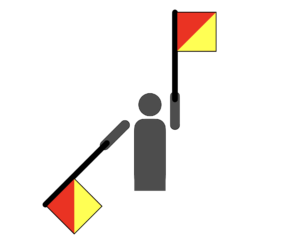
Flag semaphore indicating the Number 0. This shape represents both the Number 0 (Flag Semaphore) and the Letter K (Flag Semaphore).
Before...
More Details - Morse Code, Signals & Communication Number 0 (Morse Code)
International Morse Code sequence representing the number 0.
- Flag / Pennant, Signals & Communication Numeral 0 (Flag Pennant)
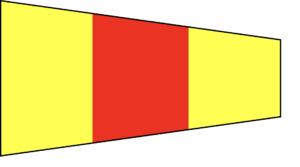
The flag represents the numerical value of zero.
- Flag Semaphore, Number Number 1 (Flag Semaphore)
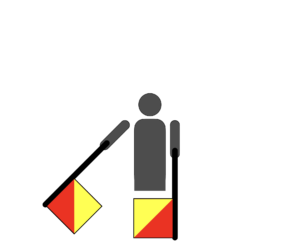
Flag semaphore indicating the number 1. This shape is the Number 1 (Flag Semaphore) and the Letter A (Flag Semaphore).
Before delivering...
More Details - Morse Code, Signals & Communication Number 1 (Morse Code)
International Morse Code sequence representing the number 1.
- Flag / Pennant, Signals & Communication Numeral 1 (Flag Pennant)

The flag represents the numerical value of one.
- Flag Semaphore, Number Number 2 (Flag Semaphore)
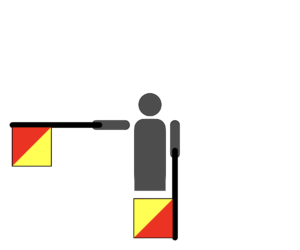
Flag semaphore indicating the number 2. This shape is the Number 2 (Flag Semaphore) and the Letter B (Flag Semaphore).
Before delivering...
More Details - Morse Code, Signals & Communication Number 2 (Morse Code)
International Morse Code sequence representing the number 2.
- Flag / Pennant, Signals & Communication Numeral 2 (Flag Pennant)

The flag represents the numerical value of two.
- Number 2 - Two (Too)
"Too" refers to the number two or the second in a series of items or actions. It can denote the quantity of something, such as two boats, two...
More Details - Flag Semaphore, Number Number 3 (Flag Semaphore)
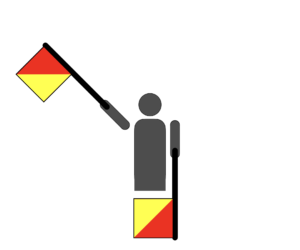
Flag semaphore indicating the Number 3. This shape represents both the Number 3 (Flag Semaphore) and the Letter C (Flag Semaphore).
Before...
More Details - Morse Code, Signals & Communication Number 3 (Morse Code)
International Morse Code sequence representing the number 3.
- Flag / Pennant, Signals & Communication Numeral 3 (Flag Pennant)
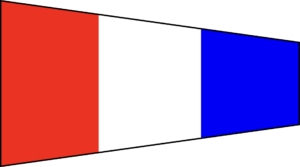
The flag represents the numerical value of three.
- Number 3 - Three (Tree)
Tree is a signal that indicates the number 3 in communication between vessels or personnel. This signal can be conveyed visually using hand...
More Details - Number 4 - Four (For Er)
"Four" is the numerical value representing the quantity of 4. In marine terminology, "four" is also used to refer to the fourth officer on a...
More Details - Flag Semaphore, Number Number 4 (Flag Semaphore)
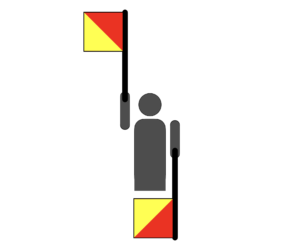
Flag semaphore indicating the Number 4. This shape represents both the Number 4 (Flag Semaphore) and the Letter D (Flag Semaphore).
Before...
More Details - Morse Code, Signals & Communication Number 4 (Morse Code)
International Morse Code sequence representing the number 4.
- Number 5 - Five (Fife)
"Five" is a numerical term representing the quantity of 5. In marine terminology, it may refer to a group of five individuals or objects, such as...
More Details - Flag Semaphore, Number Number 5 (Flag Semaphore)
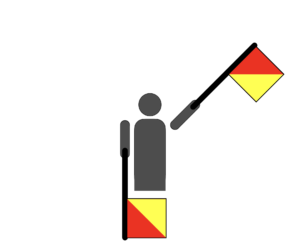
Flag semaphore indicating the Number 5. This shape represents both the Number 5 (Flag Semaphore) and the Letter E (Flag Semaphore).
Before...
More Details - Morse Code, Signals & Communication Number 5 (Morse Code)
International Morse Code sequence representing the number 5.
- Flag Semaphore, Number Number 6 (Flag Semaphore)

Flag semaphore indicating the Number 6. This shape represents both the Number 6 (Flag Semaphore) and the Letter F (Flag Semaphore).
Before...
More Details - Morse Code, Signals & Communication Number 6 (Morse Code)
International Morse Code sequence representing the number 6
- Number 6 - Six
In marine terminology, "6" or "six" does not have a specific nautical meaning. It is simply the numerical value representing the quantity of...
More Details - Flag Semaphore, Number Number 7 (Flag Semaphore)
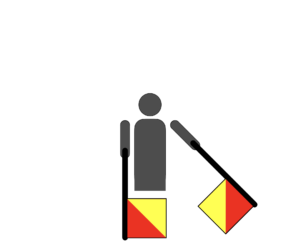
Flag semaphore indicating the Number 7. This shape represents both the Number 7 (Flag Semaphore) and the Letter G (Flag Semaphore).
Before...
More Details - Morse Code, Signals & Communication Number 7 (Morse Code)
International Morse Code sequence representing the number 7.
- Number 7 - Seven (Sev-En)
In maritime terminology, 7 or Seven (Sev-En) refers to the International Code of Signals flag representing the letter "7" in the phonetic...
More Details - Number 8 - Eight (Ait)
In marine terminology, an "ait" refers to a small island or islet located in a river or estuary. Aits are typically formed by sediment deposition...
More Details - Flag Semaphore, Number Number 8 (Flag Semaphore)
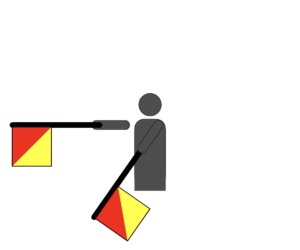
Flag semaphore indicating the Number 8. This shape represents both the Number 8 (Flag Semaphore) and the Letter H (Flag Semaphore).
Before...
More Details - Morse Code, Signals & Communication Number 8 (Morse Code)
International Morse Code sequence representing the number 8.
- Number 9 - Nine (Nin Er)
In marine terminology, "9" or "nine" is a code used to indicate the number nine in radio communications or when spelling out numbers. This code...
More Details - Flag Semaphore, Number Number 9 (Flag Semaphore)

Flag semaphore indicating the Number 9. This shape represents both the Number 9 (Flag Semaphore) and the Letter I (Flag Semaphore).
Before...
More Details - Morse Code, Signals & Communication Number 9 (Morse Code)
International Morse Code sequence representing the number 9.
- General Nautical Terminology Abaft
A position or direction towards the rear (stern) of a vessel relative to a specific point of reference on the boat.
In maritime terminology,...
More Details - General Nautical Terminology Abate
To reduce in intensity, force, or degree, especially in relation to wind, waves, or other marine conditions.
Abate refers to the lessening or...
More Details - General Nautical Terminology, Parts of a Boat Abeam
The position or direction at right angles to the centreline or keel of a vessel, typically on either side of the boat.
Abeam describes...
More Details - General Nautical Terminology, Nautical Saying Above board
Something done openly, honestly, and straightforwardly without deceit or dishonesty. It originates from pirates hiding crew members below deck...
More Details - General Nautical Terminology Above deck
The area of a boat or ship located on the main deck or any higher deck levels. This area is typically exposed to the elements and is where...
More Details - General Nautical Terminology Accidental Gybe
An unintentional and often abrupt change in a sailing vessel's course that causes the boom to swing violently across the boat, typically due to a...
More Details - Flag / Pennant, Signals & Communication Code Flag Alpha (A)

The International Maritime Signal Flag Alpha.
Meaning
I have a diver down; keep well clear at slow speed.
More Details
If appended with a Numeral... - General Nautical Terminology Adrift
A vessel that is floating without being anchored, moored, or under control, often at the mercy of wind and currents.
Adrift describes a...
More Details - Courses, RYA Advanced Pilotage
The RYA Advanced Pilotage course focuses on navigating in challenging conditions, such as night cruising or confined waterways. Participants...
More Details - Courses, RYA Advanced Plus WindsurfingThe RYA Advanced Plus Windsurfing course is aimed at experienced windsurfers seeking to push their skills to the limit. The course covers advanced... More Details
- Courses, RYA Advanced WindsurfingThe RYA Advanced Windsurfing course focuses on refining techniques for high-performance windsurfing. Participants learn advanced maneuvers such as... More Details
- General Nautical Terminology Afloat
The state of being buoyant and on the water's surface, not submerged or sinking.
Afloat is a term commonly used in the maritime world to...
More Details - General Nautical Terminology Aft
The rear or stern section of a vessel, towards the back of the boat or ship.
Aft is a directional term used to describe the position or...
More Details - General Nautical Terminology After Deck
The portion of a vessel's deck located towards the stern, or rear, of the ship.
The after deck, sometimes referred to as the aft deck, is a...
More Details - General Nautical Terminology Aground
The situation when a vessel is stuck on the seabed or shore, unable to move freely in the water.
When a vessel is aground, the hull has come...
More Details - General Nautical Terminology Ahead
The direction in front of a vessel, typically along its forward course or heading.
In maritime terminology, ahead is commonly used to describe...
More Details - General Nautical Terminology Ahoy!
A nautical greeting or hail used to attract attention, signal presence, or establish communication between vessels or individuals at...
More Details - General Nautical Terminology Air Cushioned Vessel
A type of watercraft that uses a cushion of pressurised air beneath its hull to reduce friction and enable movement over water, land, or other...
More Details - General Nautical Terminology AIS
A maritime communication system that automatically transmits and receives vessel information such as position, speed, and course to enhance...
More Details - General Nautical Terminology Alee
The side of a vessel that is sheltered from the wind, also known as the leeward side.
Alee is a nautical term used to describe the side of a...
More Details - Flag Semaphore, Signals & Communication Letter A (Flag Semaphore)

This shape represents the Letter A (Flag Semaphore) and the Number 1 (Flag Semaphore).
The presumed signals are letters. The signaller...
More Details - Morse Code, Signals & Communication Letter A (Morse Code)
International Morse Code sequence representing the letter A.
- Nautical Saying All at sea
All at sea is a nautical term for a situation where a ship or boat is adrift or lost at sea without any clear direction or sense of location.
- General Nautical Terminology Aloft
A position above the deck, typically in the rigging or on the masts of a ship.
Aloft is used to describe any position above a vessel's deck,...
More Details - General Nautical Terminology Alongside
The position or location next to a vessel, dock, or quay where a ship can be moored or secured.
The term alongside is a fundamental concept...
More Details - General Nautical Terminology, Nautical Saying Aloof
Aloof originally had a different meaning than its modern-day use to describe someone emotionally distant. In maritime language, Aloof comes from...
More Details - Phonetic Alphabet, Signals & Communication Alpha
Pronounced: AL-far
Letter "A" in the phonetic alphabet system.
- Phonetic Alphabet, Signals & Communication Alpha
Pronounced: AL-far
Letter "A" in the phonetic alphabet system.
- General Nautical Terminology, Signals & Communication AM
A method of transmitting information by varying the strength (amplitude) of a carrier wave in proportion to the signal being sent.
Amplitude...
More Details - Organisation American Sailing Association (ASA)
A US-based organisation that provides sailing education, certification, and accreditation for sailing schools and instructors.
The American...
More Details - General Nautical Terminology Amidships
The central part of a vessel, both longitudinally and laterally, located between the bow and stern.
Amidships is a crucial term in nautical...
More Details - General Nautical Terminology, Signals & Communication Ampitude Modulation (AM)
A method of transmitting information by varying the strength (amplitude) of a carrier wave in proportion to the signal being sent.
Amplitude...
More Details - General Nautical Terminology Anchor
A heavy object, typically made of metal, designed to grip the seabed and hold a vessel in position.
An anchor is a crucial piece of equipment...
More Details - General Nautical Terminology Anchorage
A designated area where a vessel can be securely anchored, typically marked on nautical charts and chosen for its safe holding ground and...
More Details - General Nautical Terminology Anchor Aweigh
The moment when an anchor has been lifted off the seabed and is no longer holding the vessel in place.
The term "anchor aweigh" is a...
More Details - General Nautical Terminology Anchor Ball
A black spherical day shape hoisted on a vessel to signal that it is anchored during daylight hours.
An anchor ball is a crucial piece of...
More Details - General Nautical Terminology Anchor Buoy
A small floating marker attached to an anchor to indicate its location on the seabed.
An anchor buoy is a vital piece of equipment used in...
More Details - General Nautical Terminology Anchor Cable
A heavy-duty rope, chain, or wire used to secure a vessel to its anchor, ensuring it remains stationary in the water.
An anchor cable is a...
More Details - General Nautical Terminology Anchor Light
A white light displayed by a vessel at anchor to indicate its position to other vessels during the night or in poor visibility conditions.
An...
More Details - General Nautical Terminology Anchor Locker
A dedicated storage compartment, typically located in the bow of a vessel, used to store the anchor and its associated gear, such as the rode and...
More Details - General Nautical Terminology Anchor Roller
A fitting mounted on a boat's bow designed to guide, support, and secure the anchor and its rode during deployment and retrieval.
An anchor...
More Details - General Nautical Terminology, Safety Angle of Vanishing Stability (AVS)
The maximum angle of heel at which a vessel can recover to an upright position without capsizing.
The Angle of Vanishing Stability (AVS) is a...
More Details - General Nautical Terminology AntifoulPaint applied to hull below waterline to discourage dirt and wildlife attaching and slowing your progress. Has environmental implications
- General Nautical Terminology, Navigation APEM More Details
- General Nautical Terminology Apparent WindThe wind we feel. If the true wind is hitting the boat on the beam or in front of the beam the apparent wind will be situated between the boat... More Details
- General Nautical Terminology, Navigation Appraise, Plan, Execute, Monitor (APEM) More Details
- Organisation ASA
A US-based organisation that provides sailing education, certification, and accreditation for sailing schools and instructors.
The American...
More Details - General Nautical Terminology AshoreOn the land; or aground
- General Nautical Terminology, Parts of a Boat Astern
The area or direction behind a vessel, towards the stern.
Astern is a nautical term used to describe both a direction and a movement in...
More Details - General Nautical Terminology Asymetric Spinnaker
A large, lightweight sail with an off-centre shape, designed for sailing off the wind, typically used to improve downwind performance.
An...
More Details - Nautical Saying At loggerheads
At loggerheads is a nautical term referring to two ships positioned with their respective loggers (wooden blocks used for securing the ship's...
More Details - Flag Semaphore Attention (Flag Semaphore)
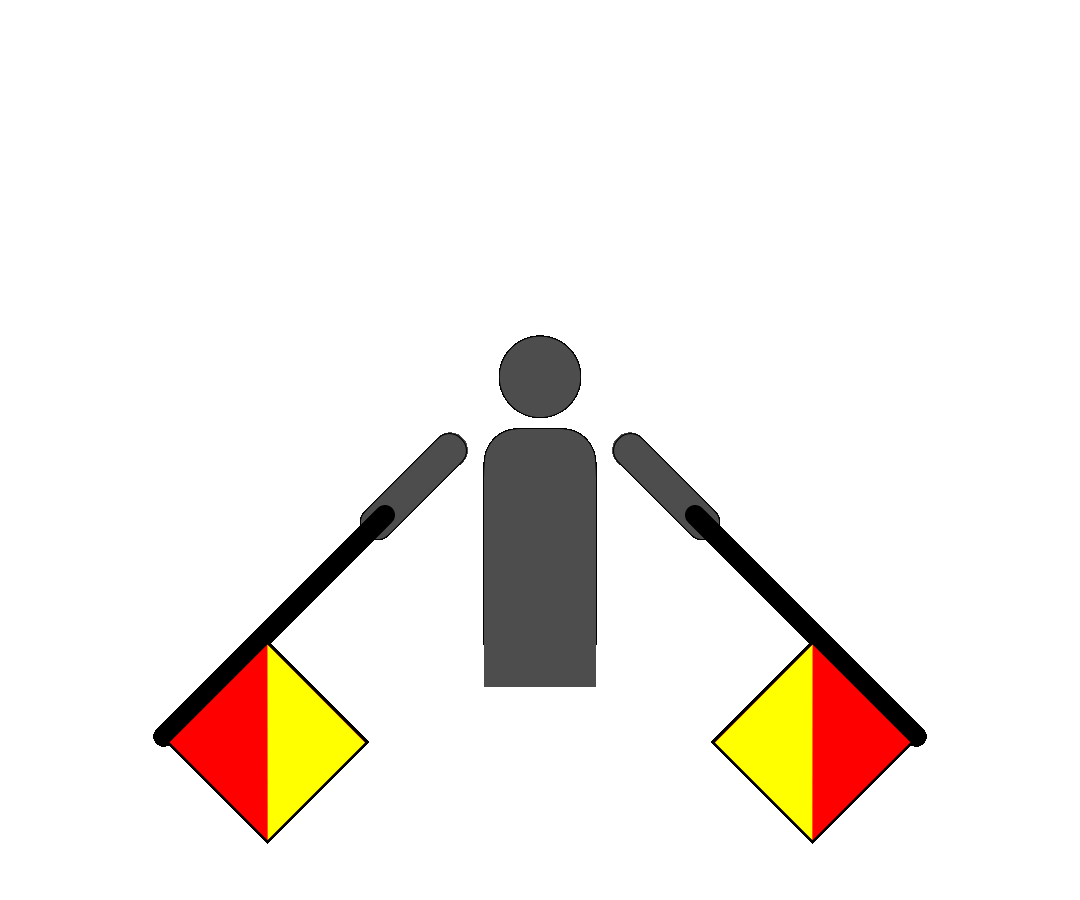
This shape is used to gain the receiver's attention and is used at the beginning of a transmission. The message recipient responds with the...
More Details - General Nautical Terminology Automatic Identification System (AIS)
A maritime communication system that automatically transmits and receives vessel information such as position, speed, and course to enhance...
More Details - General Nautical Terminology Autonomous Underwater Vehicle (AUV)
An Autonomous Underwater Vehicle (AUV) is a self-propelled, unmanned underwater vehicle capable of operating independently without direct human...
More Details - General Nautical Terminology AutopilotEquipment that allows the boat steer a course automatically using either compass bearing or a course relative to wind direction
- General Nautical Terminology AUV
An Autonomous Underwater Vehicle (AUV) is a self-propelled, unmanned underwater vehicle capable of operating independently without direct human...
More Details - General Nautical Terminology AuxiliaryA term for a saying a boat that has auxiliary power, i.e. an engine
- General Nautical Terminology, Safety AVS
The maximum angle of heel at which a vessel can recover to an upright position without capsizing.
The Angle of Vanishing Stability (AVS) is a...
More Details - General Nautical Terminology AwashLevel with the surface of the water which just washes over an object
- General Nautical Terminology Baby StayAn inner forestay
- General Nautical Terminology Back
Back (backing) describes the wind’s change in direction when it shifts counterclockwise (anti-clockwise). For example, if the wind shifts from...
More Details - General Nautical Terminology Back
To back a sail means to adjust it so that the wind blows on the opposite side from normal, causing the sail to push the boat in the opposite...
More Details - General Nautical Terminology Back StayThe backstay runs from the top of the mast to the stern of the vessel. The backstay supports the mast and in some cases can be adjusted to change... More Details
- General Nautical Terminology BailTo remove water from the bilges or cockpit
- General Nautical Terminology BailerA utensil used to bail water out of a boat
- General Nautical Terminology, Weather (Meteorology) Bailey
Sea area of the Met Office Shipping Forecast. Lies off northern Scotland near Bill Bailey’s Bank and the Orkney Islands.
Named for Bill Bailey’s...
More Details - General Nautical Terminology Ball
A spherical shape or object used as a day signal to indicate a vessel's status or condition, such as being anchored or aground.
In maritime...
More Details - General Nautical Terminology BallastAdditional weight placed low in the hull to improve stability

